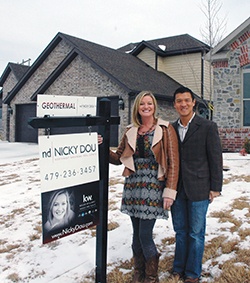Geothermal Neighborhood Promotes Clean, Energy-Efficient Development
by March 17, 2014 12:00 am 531 views

Arkansas’ first completely geothermal community is budding in Bentonville.
Ten homes have been built in the Kerelaw Castle subdivision, just off Arkansas Highway 102, and each of them employs a geothermal heating and cooling system, which saves substantial energy by tapping into stable temperatures below the earth’s surface.
Unlike traditional HVAC systems, geothermal heat pumps harness and convert underground air that ranges in temperature between 50 and 60 degrees, rather than converting outside air, the temperature of which can vary greatly, said Kala Dhana, project manager at building contractor MDS Homes Inc. of Bentonville.
The result is that the system can use one unit of energy to push five units of heating or cooling, and customers see up to 80 percent in savings in utility costs, according to ClimateMaster, the Oklahoma company that provides the service for Kerelaw.
The geothermal neighborhood is Dhana’s brainchild, but she works with her husband and business partner Dhana Subbiah, who has owned MDS Homes since 1998.
Previous to joining the business in 2005, she worked for Wal-Mart Stores Inc. Both Dhana and Subbiah have computer science backgrounds. Subbiah graduated with a master’s degree in engineering from the University of Birmingham in England. Dhana is also a certified project management professional.
She is passionate about environmental issues and believes it’s important to reduce carbon emissions in order to reduce impact on the earth. Because there is no flame heat source necessary, the geothermal systems accomplish this.
Eco-friendly housing is her cause. Many businesses give to charity, Dhana said, but MDS Homes chooses to give back to the community through their work.
She hopes geothermal heating and cooling will become a trend, as it has in other cities. But right now there are a lot of hurdles within the local development process that will prevent the use of geothermal from becoming customary practice.
For starters, geothermal heating and cooling needs to be recognized as a legitimate element of home building by several facets of the government and private sector, Dhana said.
It’s difficult to secure construction loans that include the geothermal cost and appraisers don’t take into the account the added value of using renewable energy, she said. In bigger cities, the savings in utility, carbon emission and comforts make renewable energy homes worth more.
Dhana also said she has approached, but has not yet heard back from, the city and county governments, asking them to formulate a building inspection code for geothermal installation. For the 10 homes already built, a third party inspector had to be brought in.
Also, Dhana believes it’s important for customers to feel proud to be eco-friendly home owners. MDS Homes was instrumental in renaming several streets in the subdivision to reflect this attitude. Kilmarnock Street, Kilmichael Boulevard, Grange Street and Stevenston Avenue were changed to Green World Street, Energy Avenue, Pure Globe Street and Go Green Avenue.
As a result, the homes cost about $25,000 more and take about six weeks extra to build, Dhana said. Two 300-foot holes must be dug as part of the installation process.
Right now, MDS Homes is absorbing the additional cost, and the homes are priced within the average of comparable houses without the geothermal system, Dhana said.
The homes range between 2,200 and 2,418 SF, with four bedrooms and three bathrooms.
Each home features high-end amenities, including surround sound speakers in the living room, patio speakers, stainless steel appliances, gas cooktops and covered patios, said Nicky Dou, senior vice president and executive broker of Keller Williams Market Pro Realty.
The subdivision will also feature a community pool and playground.
Kerelaw Castle listings now on the market range between $237,600 and $261,144.
This is a temporary, promotional price to give a break to those willing to get in on the ground floor of the community project.
A lot of the amenities are obvious upon first sight of a home, but this particular benefit is not evident until the owners have lived in the home, Dhana said.
“People have to feel the difference,” she said.
To test this, she and her family moved into a geothermal home a few months ago. She said she appreciates that this winter she hasn’t had the dry, itchy skin associated with traditional HVAC systems.
In addition to the health/hygienic benefits Dou estimates people who purchase these homes are eligible for at least a $7,000 tax credit, because of a law passed in 2009 that provided tax incentives for renewable energy technologies.
Kerelaw Castle was developed in 2005, but remained relatively empty until the geothermal neighborhood project started last year.
